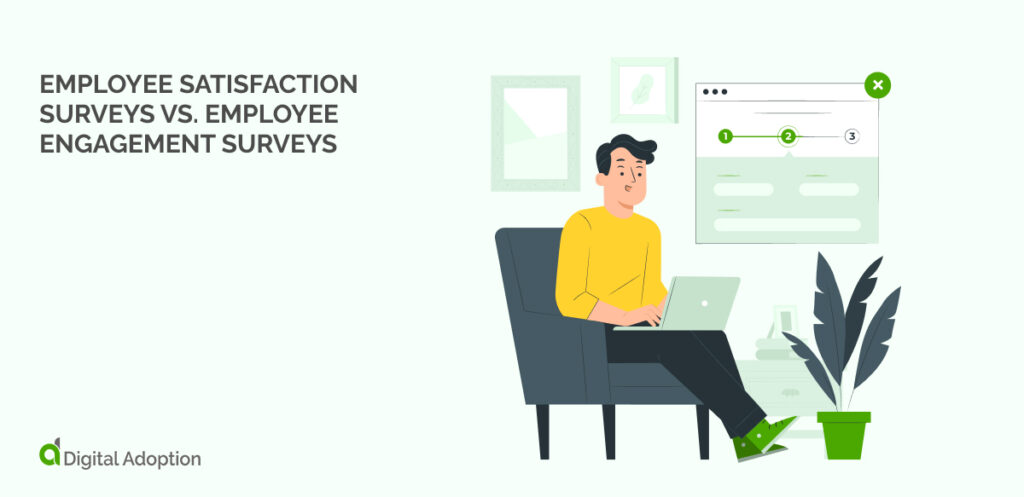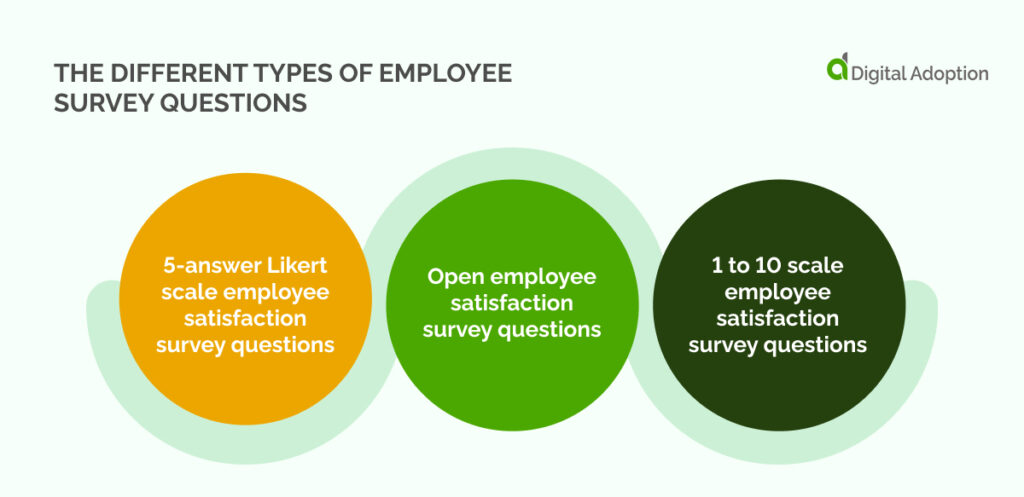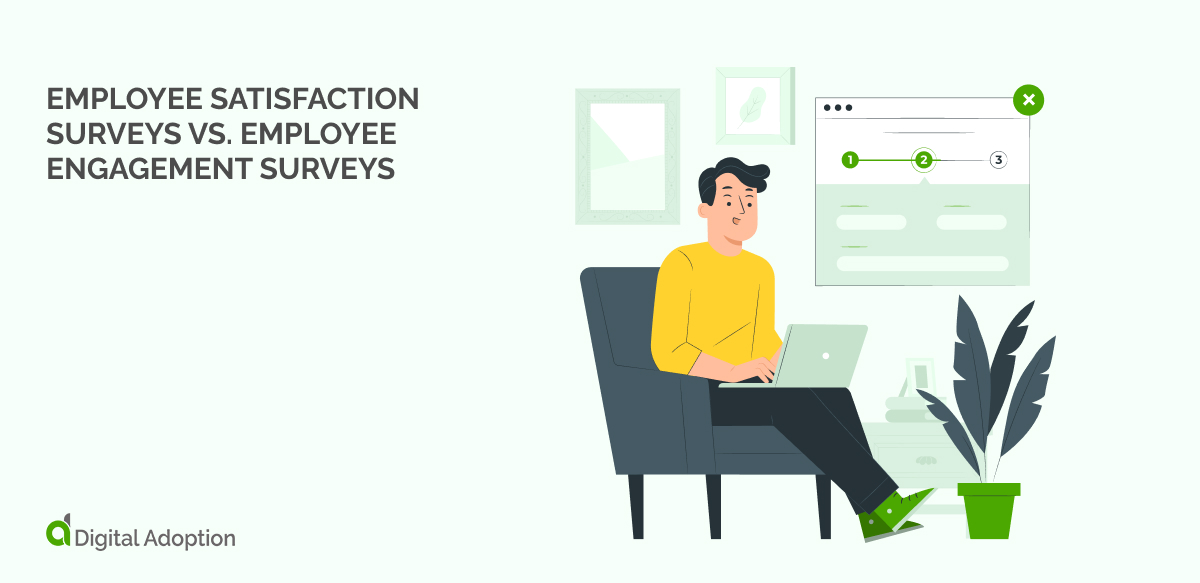Are your staff satisfied? Employee satisfaction survey questions answer that question for you in a lot of detail.
The answers may not always be easy to stomach, especially if you are undergoing a challenging employee digital transformation. But they are essential to ensuring high employee retention.
The US currently tops the world rankings for employee engagement at 74%. However, engagement decreased in 2023, showing the importance of conducting and actioning surveys to maintain high engagement with detailed, well-built surveys.
The job satisfaction rating in the US is 78%, and employee satisfaction surveys help keep up with changing staff needs. They collect data for organizations to act on and keep well-being high as you avoid employee frustration.
It is also essential to consider why your organization conducts surveys before rolling them out. Are you trying to boost dipping engagement numbers or collect views on the new employee gamification training features? Or are you trying to discover why employees don’t recommend family and friends to apply for roles?
Below, we equip you with all the knowledge you need regarding employee satisfaction survey questions to answer the above and many more questions.
We discuss the difference between employee satisfaction and engagement, provide 45 survey questions, and outline the types of survey questions.
Armed with knowledge, your employee engagement will be sky-high, and employees will never want to leave, providing you with low turnover and higher revenue.
Employee satisfaction surveys vs. employee engagement surveys

Recognizing that employee satisfaction and engagement surveys are distinct measurements is crucial. While both contribute to improving organizations’ work environments, they serve different purposes and should not be confused.
Employee satisfaction surveys serve as direct feedback tools for employees to express opinions and experiences, measuring overall contentment and pinpointing areas for improvement.
Compensation, benefits, recognition, work-life balance, workload, and company culture impact satisfaction and engagement.
Ensuring alignment with material and intangible needs is vital for retaining top talent and enhancing organizational engagement.
Employee engagement surveys gauge motivation and dedication, offer insights into workplace sentiment, and foster a culture of productivity and fulfillment.
45 best employee satisfaction survey questions
It’s helpful to divide your questions into categories to help you focus on what is essential about each question, what links them, and what information you want your staff to give to help you improve their workplace. Doing so will increase productivity and well-being and maintain high employee retention.
Role satisfaction
Role satisfaction directly impacts employee motivation, productivity, and retention. Assessing this category reveals if employees feel fulfilled in their roles, identifying areas for improvement and opportunities for professional growth within the organization.
- How happy do you feel when you’re at work?
- Do you feel your work is meaningful and valued?
- Do you feel that you have enough freedom to decide how to complete tasks?
- Do you know what is needed to meet your goals and objectives?
- Do you have the necessary materials and equipment to do your job well?
- Is your workload reasonable?
- Does your team leader distribute work evenly across your team?
- How well does your job description match your current responsibilities?
- Are your daily tasks closely related to your professional skills?
- Would you recommend our organization to your friends and family?
- Would you apply for your job again if you had to do it all over?
- Are all of your talents being used in your position?
- Does your job result in stress?
Organizational culture
Organizational culture shapes employee experiences and influences morale. Surveying this category reveals perceptions of company values, communication styles, and inclusivity, guiding efforts to strengthen culture and enhance employee engagement.
- Do you enjoy taking part in our company’s culture?
- Do you feel connected to your co-workers?
- Do you gain enjoyment when working with colleagues?
- Do you feel your colleagues work as a team?
- Do you feel valued by the company for your contributions?
- Are you satisfied working for the company?
- Is the company open to change?
- How well does the organization update you with news and important information?
- When problems arise, how well does the company handle them?
- Would you describe all mandatory staff meetings as necessary?
Professional development
Professional development opportunities foster employee growth and retention. Assessing this category reveals if employees feel supported in advancing their skills and careers, aiding in talent development and succession planning.
- Are you developing professionally?
- Do you get the learning and development opportunities that you want?
- Do you have room to grow within the organization?
- Does your job allow you to develop new skills?
- Does your job utilize your skills as much as possible?
- Does the company offer adequate opportunities for promotions and career development?
- Does the organization offer you a progressive career path?
Leadership relationships
Leadership relationships impact employee morale, engagement, and job satisfaction. Surveying this category assesses perceptions of trust, communication, and support from management, guiding efforts to enhance leadership effectiveness and employee satisfaction.
- Does your manager ask for feedback and value it when staff offer it?
- Does your direct manager value your opinions?
- Do you feel like your supervisors appreciate your roles and efforts?
- Does management seem invested in the team’s success?
- Do you feel management is transparent?
Benefits and compensation
Benefits and compensation directly affect employee motivation and retention. Surveying this category assesses perceptions of fairness, adequacy, and alignment with industry standards, guiding efforts to enhance overall compensation packages and employee satisfaction.
- Is your benefits package competitive?
- Does the company provide enough benefits regarding your well-being and mental health?
- Is your pay rate enough to keep you from taking a second job?
- How likely are you to get leave time when you need it?
- How much would you like to change about your current benefits package?
Life-work balance
Work-life balance influences employee well-being, productivity, and retention. Surveying this category reveals if employees feel supported in managing responsibilities outside of work, guiding efforts to foster a healthy work-life balance culture.
- How would you describe your stress level on a typical workday?
- Does the organization offer enough support and flexibility to thrive at work?
- Do you find yourself needing to work on weekends and at night to complete your weekly workload?
- Does the organization offer enough PTO?
- Have you ever canceled personal plans to complete your workload?
Carefully selecting employee satisfaction survey questions ensures relevant data collection, leading to data you can use to improve their workplace and conditions.
It enables your organization to address specific concerns, improve employee engagement, and foster a positive work environment tailored to their employees’ needs.
What are the different types of employee survey questions?

Choosing the correct type of employee survey questions is essential to get the correct answers. Combine the below types within your survey to get the right way to collect high-quality data from your employees to satisfy their needs, offer them what they need, and prevent departures.
5-answer Likert scale employee satisfaction survey questions
The 5-answer Likert scale measures employee satisfaction using a range of responses from strongly agree to disagree strongly. It helps collect job manageability responses.
Advantages
These questions offer a range of responses, providing nuance to employees’ sentiments. They are easy to administer and analyze, making them efficient for large-scale surveys. Their structured format ensures consistency in data collection.
Disadvantages
Limited response options may not capture the full spectrum of employee opinions. Some respondents may find the choices too restrictive, leading to potentially skewed results. Interpretation can be subjective, as individuals may interpret the scale differently.
Best organization type
This type of question is suitable for organizations seeking to measure employee satisfaction levels systematically. It’s beneficial for regular, quantitative assessments in larger corporations where consistency and scalability are priorities.
Open employee satisfaction survey questions
Open employee satisfaction survey questions allow employees to express opinions freely in their own words. They provide qualitative insights, encouraging deeper reflection and uncovering issues beyond closed-ended questions.
Advantages
Open-ended questions allow employees to express their opinions freely, providing rich qualitative data. They encourage deeper reflection and insight, uncovering issues not captured in closed-ended questions.
Disadvantages
Analyzing open-ended responses can be time-consuming and subjective, requiring manual review and interpretation. Responses may vary widely, making quantifying trends or comparing responses to benchmarks challenging.
Best organization type
Organizations aiming to gain in-depth insights into employee sentiments, particularly in smaller teams or those undergoing significant changes. Open questions are valuable for exploring specific issues or gathering feedback on new initiatives where nuanced responses are essential.
1 to 10 scale employee satisfaction survey questions
The 1 to 10 scale measures employee satisfaction with responses from highly dissatisfied to extremely satisfied. It provides granularity for precise measurement and analysis of satisfaction levels.
Advantages
This scale offers a broader range of response options, allowing for a more precise measurement of satisfaction levels. It provides flexibility in quantifying responses while offering a structured analysis format.
Disadvantages
The sheer number of response options can overwhelm respondents or lead to decision fatigue. Interpreting data may require additional effort to analyze and derive actionable insights effectively.
Best organization type
This type of question is ideal for organizations looking to quantify employee satisfaction with greater granularity. It is also suitable for industries or departments where nuanced feedback is valuable, such as customer service or product development teams.
It’s also useful for organizations seeking to track changes in satisfaction levels over time with a more precise metric.
Consider the reasons before rolling out an employee survey
Before launching an employee satisfaction survey to explore digital employee experience or other aspects of staff experiences, it’s crucial to understand its purpose. Clarifying each of your objectives helps tailor questions to employee needs and gather relevant insights effectively.
The reason might be to identify areas for improvement, measure morale, or gauge engagement. Whatever the reason, aligning survey goals with organizational needs ensures meaningful data collection.
It also enables informed decision-making to address specific issues and enhance employee satisfaction.
Reviewing the reason for the survey can help you get the correct data quickly, show your staff you care about their needs, and allow you to act on those needs.
Doing so has long-term benefits for employee retention, ensuring a fast ROI on the survey, reducing waste, and increasing employee welfare.













